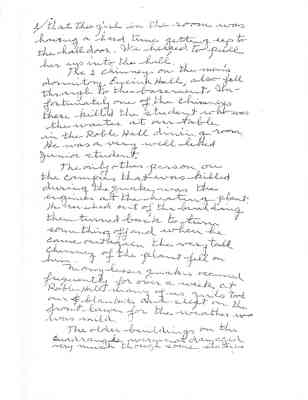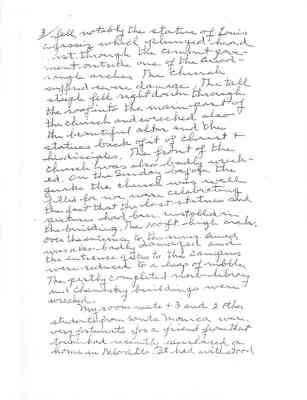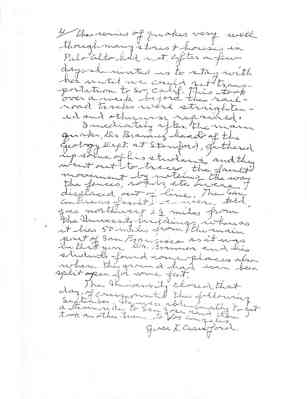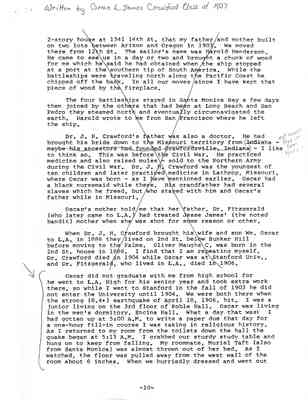Pages
1
Earthquake of April 18th, 1906 as experienced by me.
I was a Junior at Stanford University at the time of the big quake. I was living with a roommate on the 3rd floor of Roble Hall, the woman's dormitory. I had gotten up just after 5 a.m. to write a paper due that day for a 1 hour course in religious history. The quake began at 5:13. I grabbed hold of our sturdy study table in the middle of our room and hung on to keep from falling. My roommate was almost thrown out of her bed. As I watched, the floor was pulled away from the outside wall of the room about 6 inches. After the movement stopped we hurriedly dressed and went out into the main hall as did the other students on the floor. We saw that the tall chimney on the roof above us had fallen down through the single rooms under it to the basement. The chimney at the other end of the roof did the same thing. Fortunately none of the girls occupying those rooms were hurt. The floor of the room across the hall from us was sloping so much
2
2/ that the girl in the room was having a hard time getting up to the hall door. We helped to pull her up into the hall.
The 2 chimneys on the men's dormitory, Encina Hall, also fell through to the basement. Unfortunately one of the chimneys there killed the student who was the waiter at our table in the Roble Hall dining room. He was a very well liked Junior student.
The only other person on the campus that was killed during the quake was the engineer at the heating plant. He rushed out of the building then turned back to turn something off and when he came out again the very tall chimney of the plant fell on him.
Many lesser quakes occurred frequently for over a week. At Roble Hall many of us girls took our blankets and slept on the front lawn for the weather was mild.
The older buildings on the quadrangle were not damaged very much though some statues
3
3/ fell, notably the statue of Louis Agassiz which plunged head-first through the cement pavement, outside one of the quadrangle arches. The church suffered severe damage. The tall steeple fell right down through the roof into the main part of the church and wrecked also the beautiful altar and those statues back of it of Christ & his disciples. The front of the church was also badly wrecked. On the Sunday before the quake the church was well filled for we were celebrating the fact that the last statues and pictures had been installed in the building. The 100ft. high arch over the entrance to the inner quad was also badly damaged and the entrance gates to the campus were reduced to a heap of rubble. The partly completed new library and chemistry buildings were wrecked.
My room mate & I and 2 other students from Santa Monica were very fortunate for a friend from that town had recently purchased a home in Palo Alto. It had withstood
4
4/ the series of quakes very well though many stores & houses in Palo Alto had not. After a few days she invited us to stay with her until we could get transportation to So. Calif. This took over a week before the rail-road tracks were straightened and otherwise repaired.
Imediately after the main quake, Dr Branner, head of the Geology Dept. at Stanford, gathered up some of his students and they went out to trace the fault movement by noting the way the fences, roads, etc were displaced out of line. The San Andreas fault, we were told, goes northwest 3 1/2 miles from the University buildings whereas it lies 50 miles from the main part of San Francisco as it was in that year. Dr. Branner and his students found some places also where the ground had even been split open for some feet.
The University closed that day, of course, until the following September. We were able finally to get a train ride to San Jose and then took another train to Los Angeles.
Grace L. Crawford.
5
2-story house at 1341 14th St. that my father and mother built on two lots between Arizon and Oregon in 1903. We moved there from 12th St. The sailor's name was Harold Henderson. He came to see us in ta day or two and brought a chunk of week for me which he said he had obtained when the ship stopped at a port at the southern tip of South America. While the battleships were traveling north along the Pacific Coast he chipped off the bark. In all our moves since I have kept that piece of wood by the fireplace.
The four battleships stayed in Santa Monica Bay a few days then joined by the others that had been at Long Beach and San Pedro they steamed north and eventually circumnavigated the earth. Harold wrote to me from San Francisco where he left the ship.
Dr. J. H. Crawford's father was also a doctor. He had brought his bride down to the Missouri territory from Indiana – maybe his ancestors had founded Crawfordsville, Indiana {added in right margin: "not correct they came from Kentucky"} – I like to think so. This was before the Civil War. He practiced medicine and also raised mules – sold to the Northern Army during the Civil War. Dr. J. H. Crawford was the youngest of ten children and later practiced medicine in Lathrop, Missouri, where Oscar was born – as I have mentioned earlier. Oscar had a black nursemaid while there. His grandfather had several slaves which he freed, but who stayed with him and Oscar's father while in Missouri.
Oscar's mother told me that her father, Dr. Fitzgerald (who later came to L.A.) had treated Jesse James' (the noted bandit) mother when she was shot for some reason or other.
When Dr. J. H. Crawford brought his wife and son Wm. Oscar to L.A. in 1886 they lived on 2nd St. below Bunker Hill before moving to the Palms. Oliver Maughs C. was born in the 2nd St. house in 1888. I find that I am repeating myself. Dr. Crawford died in 1904 while Oscar was at Stanford Univ., and Dr. Fitzgerald, who lived in L.A., died in 1906.
Oscar did not graduate with me from high school for he went to L.A. High for his senior year and took extra work there, so while I went to Stanford in the fall of 1903 he did not enter the University until 1904. We were both there when the strong (8.4+) earthquake of April 18, 1906, hit. I was a junior living on the 3rd floor of Roble Hall. Oscar was living in the men's dormitory, Encina Hall. What a day that was! I had gotten up at 5:00 A.M. to write a paper due that day for a a one-hour fill-in course I was taking in religious history. As i returned to my room from the toilets down the hall the quake began at 5:13 A.M. I grabbed our sturdy study table and hung on to keep from falling. My roommate, Muriel Taft (also from Santa Monica) was almost thrown out of her bed. As I watched, the floor was pulled away from the west wall of the room about 6 inches. When we hurriedly dressed and went out






